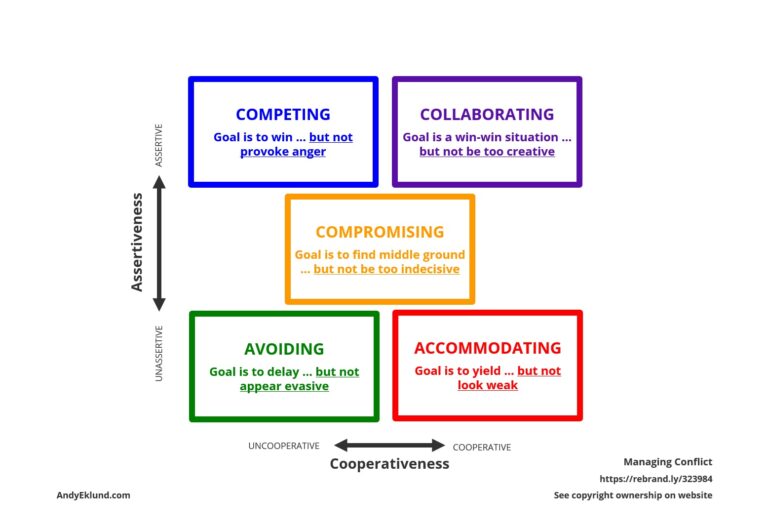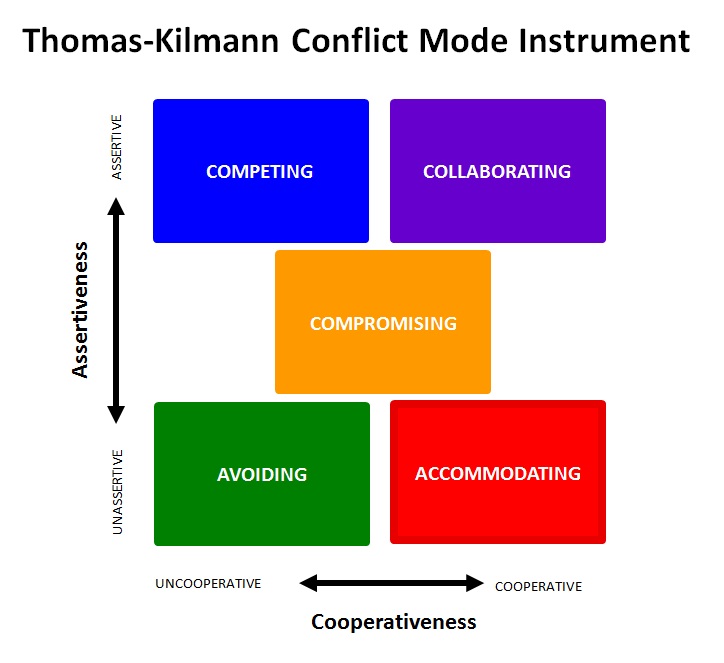Conflict – and more so, managing conflict – is simply a part of life.
Yes, conflict can be antagonistic, intimidating and paralysing. Some people address it head-on, others use it as manipulation. Other people run away as fast as possible. Others are in the middle, and may not know what to do, but they leap in and hope for the best.
For better or worse, conflict is also natural. It’s a part of life. It’s every day and everywhere. In fact, conflict is more often than not necessary and, in many ways, healthy.
Like many of us, managing conflict is a central part of the day. For me, it’s …
- Encouraging someone in a classroom to stretch what they know.
- Educating tepid people to try a new product.
- Convincing reporters to write about something they see no value for their audiences.
- Dealing with customers or vendors frustrated at changes to a particular service.
- Trying to get my daughter to understand my point-of-view as a parent.
To be successful, managing conflict is a basic skill all of us need to learn if we’re going to get what we want from life.
The basic elements of conflict are easy to learn, but maybe not so easy to put into use (at first). But, with some:
- Knowledge of how conflict works (there are specific stages to understand),
- Skills to address, perceive and manage conflict, plus
- Practice to learn and improve, especially when you don’t “win” (as it were) …
… anyone can master conflict, whether it’s entirely selfish, or advantageous for you to help staff, team members and people around you.
Let's Define Conflict
As defined by Kenneth Thomas, conflict is the condition in which people’s concerns (the things they care about) appear to be incompatible.
Note: The definition comes from Thomas’ excellent book Introduction to Conflict Management.
There’s two key words in his description: appear and incompatible.
Appear suggests a surface reaction. By investigating the situation further, other solutions may exist. (And, .)
Incompatible suggests a difference of opinion, not necessarily anger or danger.
It’s easy to associate conflict with arguing and fighting. Yet, if conflict is seen less as an emotional issue and more as differing points-of-view, it’s easier to find plausible solutions which are suitable to both parties.
I also like the definition from the Oxford English Dictionary. A serious incompatibility between two or more opinions: principles or interests.
There are two additional attributes important to note here:
Principles and Interests are the same thing – they are your needs, which are aspects not open for negotiation.
What is not mentioned in this definition are …
Positions – also known as your wants, which are aspects that are open for negotiation.
As you can imagine, there is a huge difference between negotiating on things you want versus things you need. If you want to read more, try Wants vs. Needs. You may also be interested in Some Things Are Not Up For Negotiation.
An Introduction to the Thomas-Kilmann Conflict Mode Instrument (TKI)
There are several tools, processes and philosophies in the area of conflict, some of which are particularly useful in a subset of conflict: negotiation.
Among all the tools and instruments available for individuals and teams to understand conflict in persuasion and negotiation situations, I prefer the Thomas-Kilmann Conflict Mode Instrument.
To me, it’s one of the simplest assessments to take, understand and apply to any situation.
(In case it isn’t obvious, the “Thomas” in the title is Kenneth Thomas, author of the textbook and quote above.)
Originally developed by Thomas and Ralph Kilmann from their research in the 1970s, the instrument – often shortened to TKI – demonstrates how people deal with and manage conflict.
In every conflict situation, we have two potential choices. We decide how assertive we want to be, and we decide how cooperative we want to be.
Assertiveness is the how much a person chooses to satisfy their own needs. For example, a person with high assertiveness may push for (if not force the) acceptance of their own ideas over the other party’s wishes.
Cooperativeness is how much a person chooses to satisfy the other person’s needs. For example, a person with high cooperativeness might allow others to adapt their ideas, perhaps to the point of being distorted or despite their better judgment.
These two attributes are:
Separate. They mean different things. You can be one, or the other, or both, or neither. At the same time, they are also …
Complementary. One aspect can influence the other, both positively and negatively.
The Five Modes of Conflict
When these two independent but interrelated traits are combined in a matrix, five different types of “modes” or styles emerge which show the ways which one could manage conflict.
Competing describes when a person is assertive and uncooperative. In this mode, a person tries to satisfy their own concerns at the expense of the other person. They impose their decisions, beliefs and opinions on another person or the group without little two-way discussion.
For more detail on Competing, go here.
Accommodating describes when a person is cooperative but unassertive. In this mode, a person tries to satisfy the concerns of the other person at the expense of their own. Often to their own detriment, they appease others, defer to stronger individuals or the group, or obey orders without question.
For more detail on Accommodating, go here.
Compromising describes the middle group between Competing and Accommodating: someone who is mid-way assertive and mid-way cooperative. In this mode, a person tries to find an acceptable solution that moderately satisfies both parties’ concerns. Their ideas are adequate, good enough, but rarely perfect. They’ll “do.”
For more detail on Compromising, go here.
Avoiding describes a person who is neither assertive or cooperative. In this mode, a person by-passes or postpones the conflict until later – if at all. The appropriate reasons for delaying the evitable may be to gather more information, find a more suitable time, or to avoid something which may be inappropriate, complex or uninteresting. The inappropriate reasons may be cowardice, avoidance of responsibility or they simply don’t care.
For more detail on Avoiding, go here.
Collaborating describes a person who is both assertive and cooperative. In this mode, a person makes a conscious effort to find solutions which meet all areas of concern, or which exceed the issues to ensure future obligations or expectations are satisfied. This is also the highest level of conflict management because it requires the most commitment of time, resources and energy. Even though the mode “Collaborating” sounds like the ideal, it should not be the default as there are plenty of reasons when you should not use this mode.
For more detail on Collaborating, go here.
Important Notes about all Five Modes
- No mode is good or bad.
- All modes have benefits and drawbacks, depending upon the parties and the situation.
- Each person has the ability to use any style. In fact, you probably uses all five modes in every conflict.
- For example, if deciding how to organise a project, you might use Competing to demand a certain task, but then use Accommodation for a separate task.
- People who effectively manage conflict know when to use each mode.
In the five following posts, I’ve gone into more depth for each mode, particularly to examine the benefits and drawbacks of each, including questons to ask yourself if you choose a specific mode over another.
Have you used TKI in the past? What’s your impression? How has it helped you in managing conflict?
If you’ve never heard of TKI, how have you managed conflict or your default conflict style?
As always, please feel free to add your comments and opinions below.
This article is my own interpretation of TKI. The artwork is my own.
All copyright is owned by Kenneth W. Thomas & Ralph H. Hilamn (1974), “Conflict Mode Instrument,” XICOM Incorporated, 33rd Printing, 1991.



1 Comment
Many thanks for a great post – your model is useful in defining ones own operating space, the fluidity of such a position and assists the process of effective working.